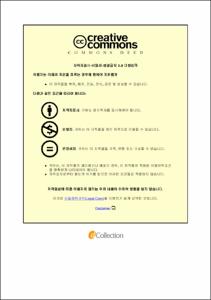우리말 색채어 표현의 의미 확장 양상 연구
- Abstract
- The purpose of this study is to analyze the aspect of the extension of the color word in Korean during the period from 15th to 19th century. To this purpose, the first step is to investigate the expression and the grammatical form of the color word in Korean using historical corpus. The second step is to reveal the basic color words(or basic color terms) in Korean and to select the examples of the extended meaning based on the analytical criteria presented in the text. The final step is to find answers to the following questions through the Semantic Information Structure Model analysis: (1) what mechanisms(Metaphor and Metonymy) are mainly used when the meaning of the color word in Korean are extended? (2) what meaning is the most entrenched? (3) are there high correlations among the extended meaning,-expression, and-grammatical form?
For detailed analysis, the color word was divided into ‘a primary color word’ and ‘a mixed color word’ and ‘a complex constitution color word’. A primary color word is like that ‘Geomda’, ‘Huida’, and a mixed color word is like that ‘Geomburgda’, ‘Geompureuda’. A complex constitution color word is different from others. It's not a word, it's just the combination of each color words to construct meaning. Example being ‘Geomgo Nureuda’.
As a result, the basic color words in Korean were ‘Geomda, Haida>Huida, Beurgda>Burgda, Peureuda>Puruda, Nureuda’. The expression and the meaning of the color words are as follows. First, the expression of the primary color words for black was ‘Geomda/Gamda, Geomeohada, Geomeoseureohada/Geomeuseureohada, Geomeomuturumhada, Geomjeong’. The meanings [SANCTITY], [INTREPIDNESS], [BADNESS], [FIERCENESS] were extended by the metaphor. In contrast, the meanings [UNHEALTHINESS], [HEALTHINESS], [GOVERNMENT OFFICIAL], [DIRT], [YOUTHFULNESS] were extended by the metonymy. Secondly, the expression of the primary color words for white was ‘Haida>Huida, Hayahada/Heoyeohada, Huiopseureohada/Huieupseureohada/Huiuseureohada, Huijocheurhada’. The meanings [SANCTITY], [UNLUCKINESS] were extended by the metaphor, and the meanings [UNHEALTHINESS], [HEALTHINESS], [SHARPNESS], [AGEDNESS], [BEAUTY], [MOURNING] were extended by the metonymy.
Thirdly, the expression of the primary color words for red was ‘Beurgda>Burgda, Bulgeohada/Beolgeohada, Burgeuseureohada, Bulgeuseureumhada, Beurghida/Burghida, Beorgeong’. The extended meaning through the metaphor was [SINCERENESS], [OMINOUSNESS], [EVILNESS], [LUXURY], and the one through the metonymy was [UNHEALTHINESS], [HEALTHINESS], [SHAME], [ANGRINESS], [SELF-INTERESTEDNESS], [BEAUTY], [PATBAP]. Next, the expression of the primary color words for blue was ‘Peureuda>Pureuda, Peureohada/Parahada/Peoreohada, Pureuseureohada, Peoreong’. The extended meaning through the metaphor was [FRUGALNESS], [HIGH GOVERNMENT OFFICIAL], [BEAUTIFULNESS], [NORMALNESS], [SANCTITY], and the one through the metonymy was [UNHEALTHINESS], [A LOW SOCIAL POSITION]. Finally, the expression of the primary color words was ‘Nureuda/Norada, Nureohada/Norahada, Nuruseureohada/Nuraseureomhada, Norang’. The extended meaning through the metaphor was [SANCTITY], [FIERCENESS], [EVILNESS], and the one through the metonymy was [UNHEALTHINESS], [HEALTHINESS], [FRUGALNESS].
The mentioned extended meanings can be observed as the linguistic metaphor and metonymy derived from higher conceptual metaphor and metonymy. The higher conceptual metaphor is [POSITIVE IS X(COLOR WORD)], [NEGATIVE IS X(COLOR WORD)] whereas the higher conceptual metonymy is [EFFECT FOR CAUSE], [PART OF A THING FOR THE WHOLE THING], [PROPERTY FOR CATEGORY].
The composition of the mixed color words was ‘achromatic+chromatic, chromatic+chromatic, chromatic+achromatic’, and the expression of the mixed color words was ‘Geombeurgda/Geomburgda/Gambargda, Geompeureuda/Geompeurada/Gamparada, Geomnureuda’, and ‘Balgaparahada, Parabalgahada, Peureonureohada’, and ‘Nureogeomeohada’. The ‘achromatic+chromatic’ color words were formed by the Asyntactic Compounding and the rest was by the Syntactic Compounding. The extended meaning through the metaphor was [NORMALNESS], [FINENESS], and the one through the metonymy was [UNHEALTHINESS], [HEALTHINESS].
The extended meaning of the complex constitution color words through the metaphor was [OMINOUSNESS], [UNLUCKINESS], [INNOCENCE], [SANCTITY], [FIERCENESS], [INTREPIDNESS] whereas the one through the metonymy was [UNHEALTHINESS], [HEALTHINESS], [ANGRINESS], [DEATH], [SHAME]. The metaphorical meaning of the mixed color words and the complex constitution color words was a subtype of [POSITIVE IS X(COLOR WORD)], [NEGATIVE IS X(COLOR WORD)] and the metonymical meaning of those was a subtype of [EFFECT FOR CAUSE].
In summary, first, the color word in Korean extended either the positive meaning or the negative meaning through the metaphor. The meaning of the color word extended ‘Physical state expression’, ‘Psychological state expression’, and ‘Object instruction expression’, ‘Object state representation’ through the metonymy. Secondly, the metonymy is the main mechanism of the extension of the color word in Korean. Thirdly, the most of the extended meaning is ‘Physical state expression’. Fourthly, the higher the degree of semantic entrenched, the more the meaning extended based on the diverse expression and grammatical form. Fifthly, the main grammatical form was a modifier form(V-ETM) whereas the extended meaning [UNHEALTHINESS] was extended based on a conjunctive form(VC). Finally, the color words for white and blue are expanding to positive meaning in contrast the ones for black and red are extending to negative meaning.
- Issued Date
- 2018
- Awarded Date
- 2018.2
- Type
- Dissertation
- Publisher
- 부경대학교
- Affiliation
- 부경대학교 대학원
- Department
- 대학원 국어국문학과
- Advisor
- 채영희
- Table Of Contents
- 1. 들어가기 1
1.1. 연구의 목적과 필요성 1
1.2. 선행 연구 검토 5
1.3. 연구 대상과 방법 15
2. 기본색채어와 의미정보구조 모형 23
2.1. 기본색채어의 개념과 조건 23
2.2. 인지문법에서의 기본 전제 25
2.3. 개념적 과정 32
2.4. 의미정보구조 모형 설정 근거 44
3. 단일색채어 표현과 의미 분석 48
3.1. 검은색류 어휘 48
3.2. 흰색류 어휘 63
3.3. 붉은색류 어휘 73
3.4. 푸른색류 어휘 83
3.5. 노란색류 어휘 92
4. 혼합색채어와 복합구성색채어 표현과 의미 분석 101
4.1. 혼합색채어류 어휘 101
4.2. 복합구성색채어 의미 분석 110
5. 우리말 색채어 의미 확장 양상 116
5.1. 색채어 의미 확장 방향 116
5.2. 색채어 의미정보구조 모형 119
5.3. 색채어 의미 확장 양상 127
6. 마무리 131
* 참고문헌 134
- Degree
- Doctor
- Files in This Item:
-
-
Download
 우리말 색채어 표현의 의미 확장 양상 연구.pdf
기타 데이터 / 2.3 MB / Adobe PDF
우리말 색채어 표현의 의미 확장 양상 연구.pdf
기타 데이터 / 2.3 MB / Adobe PDF
-
Items in Repository are protected by copyright, with all rights reserved, unless otherwise indicated.